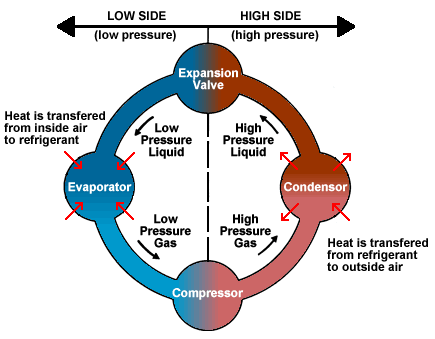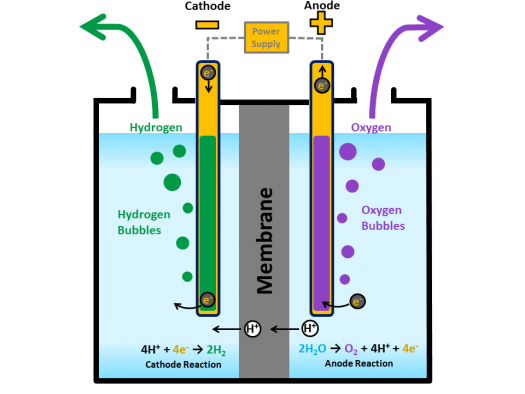HOME
ATMOSPHERE CONTROL
With the cold ocean surrounding the submarine, it might
be hard to believe that the on board equipment would cause
an intolerable build up of heat if not for air
conditioning, but it would. Other considerations for
atmosphere control include maintaining various gases at
concentration levels that emulate the Earth's air.
AIR CONDITIONING
Air conditioning (A/C) has importance beyond that of crew
comfort. Most of the equipment has been designed to
rely on a certain ambient temperature to function
normally. In some emergencies, most notably a steam
line rupture, restoring A/C, if ever lost, is a priority
since it condenses the steam in the air to make engine
room reentry possible. Losing A/C is common since
the electrical distribution is setup to default to a
lineup that drops all non-vital loads, of which A/C is
one, during many emergencies. From experience, it
takes less than an hour without A/C for the engine room to
reach about 120° F.
As with any heat cycle, an A/C cycle always has a heat
source and heat sink. People are used to those being
the inside air and the outside air respectively for home
A/C. On board the Ohio class submarine, they are the
chill water system and one of the seawater cooling systems
respectively. Chill water is a freshwater system
that circulates cold water throughout the the ship,
absorbs ambient heat with air-to-water heat exchangers,
and returns to the A/C units to be cooled again for
reuse. The heat brought back to the A/C units is
transferred from the chill water to refrigerant and then,
on the other side of the A/C cycle the refrigerant gives
off it's heat to seawater. The principles of A/C are
based on the special properties of refrigerant, in that it
has a low boiling point and a high heat of
vaporization. The air conditioning cycle is
described in the image below. Note that this graphic
was created with home heat source and heat sinks in mind.

IMAGE SOURCE: SWTC
VENTILATION
The submarine also has a ventilation system to control
air flow in various areas of the ship as well as ensure
air composition is uniform. The ventilation system
is actually the common way that oxygen is replenished, not
generating it like many believe. Normally,
ventilation is lined up for recirculation. On a
routine basis, the ship approaches the surface, extends
the snorkel, and either ventilates the ship with fans or
starts up the diesel generator. The diesel is
capable of taking a suction (because internal combustion
engines require air) on any of the three
compartments. Whether done by fans or by the diesel,
this operation creates a slightly lower pressure inside
the ship allowing the higher pressure of the outside to
cause fresh air to flow into the ship through the snorkel.
Even on recirculation, ventilation ensures that waste
gases, such as CO from cooking do not build up in one
place and are instead allowed a chance to visit one of the
machinery rooms where disposal equipment is located.
Ventilation plays an important role for many major
emergencies. During a fire, for instance,
ventilation of the affected compartment needs to be
isolated from the rest of the ship to keep fresh O2
out and smoke in. After the fire is put out,
ventilation is then used to evacuate the compartment of
smoke using the snorkel method described above.
Another example is a steam rupture. In such an
event, it likely has over-pressurized the engine room,
making it impossible for any amount of human strength to
open the door for reentry, so ventilation can be used to
equalize pressure between the engine room and the rest of
the ship.
GENERATING OXYGEN
If the submarine is in a situation that requires it to
maximize stealth for a long period of time, snorkeling
becomes impossible. Oxygen can then be replenished
by electrolysis of water.
In essence, high current electricity is used to separate
the elemental components of H2O to create O2
and H2. The O2 is used while
the H2 is disposed of.

IMAGE SOURCE: energy.gov
CARBON DIOXIDE AND OTHER GASES
CO2 removal is done chemically in CO2
scrubbers. Mono-ethanol amine (MEA) is a chemical
that naturally absorbs CO2. MEA becomes
reusable when it is heated, which forces the CO2
out to be captured. From there, the CO2
is pumped overboard.
Other gases are produced at a much slower rate, but still
poses a danger in a sealed environment like a
submarine. The most common of these lesser gases are
CO and H2. For these, the ship has CO-H2
burners. Lithium bicarbonate and a catalyst is
heated to very high temperatures and the submarine's air
is blown over these chemicals so that any CO is converted
to CO2 and any H2 converted to
water. Both are disposed of overboard.